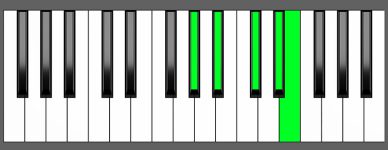Piano Diagram of C#m6/9 in Root Position

The C#m6/9 chord is a minor chord based on the C# key (C#, E, G#) but with additional major 6th (A#) and major 9th (D#) intervals. In this article, we will explore the music theory behind this chord in greater detail.
Structure of C#m6/9
Notes |
|---|
| C#, E, G#, A#, D# |
Intervals |
|---|
| R, m3, 5, 6, 9 |
C#m6/9 Chord Inversions
The C#m6/9 chord has a total of 4 inversions:
| Root Position: | C# | E | G# | A# | D# |
| 1st Inversion: | E | G# | A# | C# | D# |
| 2nd Inversion: | G# | A# | C# | D# | E |
| 3rd Inversion: | A# | C# | D# | E | G# |
| 4th Inversion: | D# | E | G# | A# | C# |
Piano Keyboard Diagrams

Chord Inversion on Piano
Chord inversions are a fundamental concept in music theory that explains how chords are constructed and fit into progressions. However, when discussing chord inversions on a piano keyboard, it’s essential to note that the diagrams used to show the notes in an inversion may not always be practical for playing.
In actual practice, pianists use different voicings and fingerings for chords, spreading the notes across various octaves and positions on the keyboard. This means that the basic shape of a chord’s inversions as depicted in diagrams might not always be the most effective way to play the chord on a piano keyboard.
How to play a C#m6/9
To play the C#m6/9 chord, you can start by playing the root note C# with your left hand. Then, using your right hand, play the minor 3rd E, the 6th A#, and the 9th note D#. This simplifies the C#m6/9 chord to include only the root note, minor 3rd, major 6th, and 9th notes.
C# + E, A#, D#
Pianists often modify these chords for ease, excluding certain notes like the root or the 5th. Another approach is dividing the chord between hands, playing either full or partial chords in each hand. However, voicing chords on the piano is a nuanced topic that requires more explanation.
Keep in mind that these suggestions are general and may not suit every musical context.
Music Theory and Harmony of C#m6/9
Building the C#m6/9 Chord: Different Approaches
Starting from the C# Major Scale
To build a minor 6/9 chord, you would typically include the root note, minor third, fifth, sixth, and ninth from a minor scale. However, when teaching this concept, it can be more effective to demonstrate its construction using a major scale. This is because a major scale better illustrates the relationship between intervals and their respective qualities.
So let’s take the C# major scale:


Apply the formula R, m3, 5, 6, 9 to get a C#m6/9 chord:
- Select the Root note, which is C#.
- Pick the 3rd note, which is E#, then lower it down by a half step to get the minor 3rd E.
- Add the 5th note, which is G#, and include it as well.
- Now, add the 6th which is A#.
- Lastly, include the 9th note of the C# Major scale, which is a D#.
by Combining Intervals
To build a minor 6/9 chord, one approach is to combine specific intervals, namely a minor 3rd, a major 3rd, a major 2nd (whole-tone), and a perfect 4th.
m3 + 3 + 2 + 4 = m6/9 Chords
In a C#m6/9 chord, you can see that:
- C#-E forms a minor 3rd,
- E-G# creates a major 3rd,
- G#-A# makes a whole-tone interval,
- and A#-D# is a perfect 4th.
Stacking these intervals together creates a C#m6/9 chord.
How to Use C#m6/9 in a Chord Progression
C#m6/9 chords can be used as a variation of minor chords. However, it’s important to understand that the major 6th and/or the 9th interval present in this chord may not always be a part of the scale being used.
on Natural minor Scales
| Minor Scales | i | ii | III | iv | v | VI | VII |
|---|---|---|---|---|---|---|---|
| C# | C# min7 ⇒ C#m6/9 | D#m7b5 | E Maj7 | F# min7 | G# min7 | A Maj7 | B7 |
| G# | G# min7 | A#m7b5 | B Maj7 | C# min7 ⇒ C#m6/9 | D# min7 | E Maj7 | F#7 |
| F# | F# min7 | G#m7b5 | A Maj7 | B min7 | C# min7 ⇒ C#m6/9 | D Maj7 | E7 |
- Non-diatonic Tonic chord in C# minor
- Subdominant chord in G# minor
- Non-diatonic Dominant chord in F# minor
on Major Scales
| Major Scales | I | ii | iii | IV | V | vi | vii |
|---|---|---|---|---|---|---|---|
| B | B Maj7 | C# min7 ⇒ C#m6/9 | D# min7 | E Maj7 | F#7 | G# min7 | A#m7b5 |
| A | A Maj7 | B min7 | C# min7 ⇒ C#m6/9 | D Maj7 | E7 | F# min7 | G#m7b5 |
| E | E Maj7 | F# min7 | G# min7 | A Maj7 | B7 | C# min7 ⇒ C#m6/9 | D#m7b5 |
- Supertonic chord in B Major
- Non-diatonic Mediant chord in A Major
- Non-diatonic Submediant chord in E Major
Non-diatonic positions
In the case of the C# minor 6/9th chord, the A# does not exist in either the C# natural minor scale or the E major scale.
In F# minor and A Major, both, the 6th (A#) and the 9th (D#) are not present in the scales. This is why the C#m6/9 chord (and any other chords with non-scale tones) are called “non-diatonic.”
As a result, it is possible that the inclusion of this chord could cause dissonance within a melody or harmonic progression. So, just be careful when you use this chord in your music. Make sure it works well with the other chords and notes.
C#m6/9 Function in Major and Minor Keys
Understanding Scale Degrees
Scale degrees are essential for understanding the relationship between the notes in a scale and how they function within chords. The diatonic major scale consists of seven degrees, each with its unique role in creating the overall harmony of the scale.
- The first degree of the scale is known as the Tonic, which serves as the anchor for the music. It establishes a stable tonal center that acts as the foundation for the scale.
- The second degree is called the Supertonic, often used as a transitional note between the Tonic and other notes in the scale. It creates a sense of motion within the melody or harmony.
- The third degree of the scale is the Mediant, which sits halfway between the Tonic and Dominant notes. It helps establish whether the scale is major or minor.
- The fourth degree is called the Subdominant, used to complement the Dominant and add tension and resolution to the music.
- The fifth degree is the Dominant, which creates tension and anticipation within the melody or harmony, typically resolved by returning to the Tonic.
- The sixth degree is the Submediant, often employed as a transitional note between the Dominant and Tonic, adding a sense of stability and restfulness to the music.
- The seventh degree is the Leading tone, located one half-step below the Tonic. It creates a strong sense of tension and a desire to resolve to the Tonic, frequently used to create a sense of resolution and finality in the melody or harmony.
C#m6/9 in C# minor (Non-Diatonic)
The C#m6/9 chord can be used as the tonic chord in the C# natural minor scale, but it’s non-diatonic due to the presence of the major 6th interval (A#), which creates tension and dissonance. While this dissonance can add interest to the chord, it may also make it challenging to use in certain musical contexts.
| i | ii | III | iv | v | VI | VII |
| C# min7 ⇒ C#m6/9 | D#m7b5 | E Maj7 | F# min7 | G# min7 | A Maj7 | B7 |
C#m6/9 Chord Progressions as i degree
Here are some examples of chord progressions where the C#m6/9 chord can serve as the tonic chord (i degree). I have provided a possible chord voicing just as a suggestion.
i VI VII III
| i | VI | VII | III |
| C#m6/9
C# (E, A#, D#) |
A Maj7
C# (E, G#, C#) |
B7
B (D#, F#, A, B) |
E Maj7
E (G#, B, D#) |
You can play the root note with your left hand and the remaining notes within the brackets with your right hand.
Chromatic modulation
| i | iΔ | i7 | i6 |
| C# min
C# ( E, G#, C#) |
C# min(Maj7)
C# (E, G#, B#) |
C# min7
C# (E, G#, B) |
C#m6/9
C# (D#, E, A#) |
i iv VI VII
| i | iv | VI | VII |
| C# min7 | C#m6/9
C# (E, G#, B) | C# (D#, E, A#) |
F# min7
F# (E, F#, A) |
A Maj7
A (C#, E, G#) |
B7
B (A, D#, F#) |
C#m6/9 in G# minor
The C#m6/9 can also appear as a variation of the subdominant chord in the key of G# minor.
| i | ii | III | iv | v | VI | VII |
| G# min7 | A#m7b5 | B Maj7 | C# min7 ⇒ C#m6/9 | D# min7 | E Maj7 | F#7 |
C#m6/9 Chord Progressions as iv degree
The following chord progressions feature a C#m6/9 chord as the subdominant (iv degree):
iv III VI VII
| iv | III | VI | VII |
| C#m9 | C#m6/9
C# (D#, E, B) | C# (D#, E, A#) |
B Maj7
B (D#, F#, A#) |
E Maj7
E (D#, G#, B) |
F#7
F# (D#, E, A#) |
You can play the root note with your left hand and the remaining notes within the brackets with your right hand.
i iv VI v
| i | iv | VI | v |
| G# min7 | C#m6/9 | C#m7 | E Maj7 | D# min7 |
C#m6/9 in F# minor (Non-Diatonic)
Typically, it’s best to avoid playing a C#m6/9 chord in the key of F# minor since it contains two notes that aren’t part of the F# minor scale. However, it’s also helpful to experiment with different chord positions, including those that may seem “impossible,” to gain a better understanding of when and where to use certain chords. This hands-on experience can serve as a valuable learning tool and guide, rather than solely relying on guidelines that tell you where not to use a chord.
| i | ii | III | iv | v | VI | VII |
| F# min7 | G#m7b5 | A Maj7 | B min7 | C# min7 | D Maj7 | E7 |
C#m6/9 as v degree – Chord Progressions
If you want to hear how the C#m6/9 chord sounds as the dominant (V) chord in the F# natural minor scale, try playing the following chord progressions. It may sound slightly dissonant due to the absence of the 6th (A#) and 9th (D#) in the F# minor scale. Consider adding chromaticism to your chord voicings, and the C#m6/9 chord can be particularly useful for this purpose in this key.
i iv VI v
| i | iv | VI | v |
| F# min7 | B min7 | D Maj7 | C#m7 | C#m6/9 |
i v VI VII
| i | v | VI | VII |
| F# min7 | C#m7 | C#m6/9 | D Maj7 | E7 |
i VI v iv
| i | VI | v | iv |
| F# min7 | D Maj7 | C#m7 | C#m6/9 | B min7 |
C#m6/9 in B Major
In the key of B major, the C#m6/9 chord can be used as a supertonic chord, which is a chord built on the second degree of the scale. This chord can add color and variety to a progression that already includes a C#m chord on the same degree.
| I | ii | iii | IV | V | vi | vii |
| B Maj7 | C# min7 ⇒ C#m6/9 | D# min7 | E Maj7 | F#7 | G# min7 | A#m7b5 |
C#m6/9 Chord Progressions as ii degree
Try playing the following chord progressions to better understand how the C#m6/9 chord functions as the supertonic (ii) chord in the key of B major.
ii V I
| ii | V | I |
| C#m6/9 | F#7 | B Maj7 |
I IV ii V iii vi ii V
| I | IV | ii | V | iii | vi | ii | V |
| B Maj7 | E Maj7 | C#m6/9 | C#m7 | F#7 | D# min7 | G# min7 | C# min7 | F#7 |
C#m6/9 in A Major (Non-Diatonic)
In the key of A major, the C#m6/9 chord can be used as a non-diatonic substitution for the mediant chord on the III degree. This chord can add a unique color to the progression, but it’s important to note that it contains an A# and a D# which are not present in the A major scale. As with any non-diatonic chord, it’s important to use it tastefully and appropriately to avoid disrupting the overall harmony of the piece.
| I | ii | iii | IV | V | vi | vii |
| A Maj7 | B min7 | C# min7 ⇒ C#m6/9 | D Maj7 | E7 | F# min7 | G#m7b5 |
C#m6/9 Chord Progressions as iii degree
To better understand how the C#m6/9 serves as the mediant (iii) in the A major scale, you can try playing the following chord progressions.
I iii IV V
| I | iii | IV | V |
| A Maj7 | C# min7 | C#m6/9 | D Maj7 | E7 |
I iii ii V
| I | iii | ii | V |
| A Maj7 | C# min7 | C#m6/9 | B min7 | E7 |
I iii vi V
| I | iii | vi | IV |
| A Maj7 | C# min7 | C#m6/9 | F# min7 | D Maj7 |
C#m6/9 in E Major (Non-Diatonic)
The C#m6/9 chord may not be a good fit for the E major key because it includes an A# note which is not part of the E major scale. However, it’s still worth experimenting with this chord in this key to see how it sounds to you.
| I | ii | iii | IV | V | vi | vii |
| E Maj7 | F# min7 | G# min7 | A Maj7 | B7 | C# min7 | D#m7b5 |
C#m6/9 as vi degree – Chord Progressions
You can explore the sound of C#m6/9 as the submediant chord in the key of E major by playing the following chord progressions:
I iii vi V
| I | iii | vi | V |
| E Maj7 | G# min7 | C# min7 | C#m6/9 | B7 |
I vi ii V
| I | vi | ii | V |
| E Maj7 | C#m6/9 | F# min7 | B7 |
I IV ii V iii vi ii V
| I | IV | ii | V | iii | vi | ii | V |
| E Maj7 | A Maj7 | F# min7 | B7 | G# min7 | C#m6/9 | C#m | F# min7 | B7 |
Alternative Names for C#m6/9 Chord
- C# -6/9
- Do#-6/9
- C# m6/9
- C# m6/9th
- C# min 6/9
- C# m9(add6)
- C# min9 add 6
- C# minor 6th 9th
- C# minor sixth-ninth
Conclusion
The chord progressions and examples presented in this post provide a comprehensive overview of the most common uses of the C#m6/9 chord. It’s important to note, however, that many advanced harmony-related topics could not be included due to space constraints. These topics include chord progressions built on harmonic and melodic scales, modal scales, hidden tonality, secondary dominants and other chord substitutions, non-functional harmony and atonal music, modal interchange and borrowed chords, voice leading and counterpoint, chromatisms, jazz harmony…I mean, music theory is a huge topic!
Although I couldn’t cover all of these topics in my post, I encourage readers to continue exploring these areas in their own study and research. By expanding your knowledge in these advanced areas of music theory, you can gain a deeper understanding of the harmonic possibilities that exist beyond the basics presented here.



